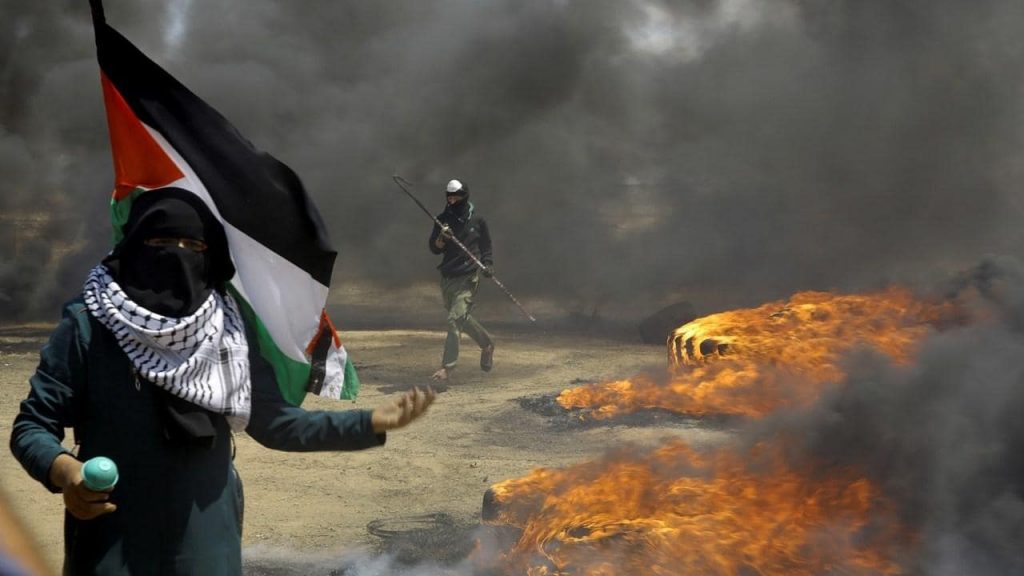Australia/Israel Review
A Syria-Gaza Link?
Aug 6, 2018 | Tony Badran

Israel is about to face two active fronts on its borders: One in Gaza, and the other in the Golan Heights. As factions in Gaza fired rockets at Israel, an offensive by the alliance backing the Assad regime was underway in southern Syria, likely to reach the Golan border soon. While this might appear to be a random coincidence, it’s more by design: The escalating attacks from Gaza should be seen as part of a coordinated Iranian strategy.
After the outbreak of the Syrian war, the Iranians considered establishing southern Syria as yet another active front on Israel’s borders. This is a red line for Jerusalem. Consequently, over the past year especially, the Israeli Air Force has been bombing Iran’s military infrastructure in Syria at will. Russia’s presence in Syria has not translated into protection for Iran and the forces it commands in the war-torn country. And the Iranians have had no effective answer to Israel’s intelligence dominance and military superiority in Syria. The feeble rocket attack on the Golan Heights in May underscored this point.
That, however, doesn’t mean the Iranians are folding. Teheran might not be about to sacrifice its holdings in Lebanon by heating up the Lebanese front against Israel, which would lead to Jerusalem devastating Hezbollah’s home base. But there is another, less costly option to turn the heat on Israel: Gaza.
The Iranian logic is simple enough. Even though south-western Syria was part of the so-called “de-escalation” agreement, which the US, Russia, and Jordan reached last year, the Assad regime camp, backed by Russian air power, is now in the middle of an offensive to retake the area and return the Assad regime to the borders with Jordan and Israel. Of course, the Russians “pinky promise” that only the Syrian “state” will be present at the border.
The Iranians and Hezbollah, the Russians say, either will not be deployed there, or, if they are, would gradually withdraw. Vladimir Putin guarantees it! The Israelis, at their end, hope that their proven record will deter the Iranians from moving on the Golan. At the same time, the Iranians will keep the Gaza front simmering. Their play, in other words, is to try to deter the Israelis from taking decisive action on either front.
Anyone looking for further evidence in support of this observation should simply study the Assad regime’s offensive in southern Syria, which has been mainly in the eastern part of Dara’a, down to the Jordanian border. This is the safer approach. The push toward the western part, Quneitra and the Golan, carries the risk of Israeli action, especially since the Iranian-led militias are embedded with whatever remains of Assad’s military, and there is documentation of their participation in the offensive. Despite reports over the past month of an understanding between Russia and Israel concerning the regime’s return to the area, there’s been no agreement on the issue of Iran’s presence.
There’s been a lot of speculation about what the conversation with Russia will lead to. But in all likelihood, the rules of whatever “deal” may be reached is that Moscow is not responsible for either what the Iranians or the Israelis do. That is to say, Russia will do nothing about Iran, and Israel will continue to target the Iranians in Syria at will.
The benefit that Putin is eyeing is for him to become the broker that everyone has to go through – without having his advanced weapons systems publicly destroyed.
Once the Assad regime military campaign finds its way to Israel’s border, Iran will as well – whether immediately or down the road makes little difference. Israel will have to take action, with the de facto buffer zone on its border gone.
Iran’s assets don’t stand a chance against Israel in a full-on war. But low intensity conflict can work to their advantage. The Iranians’ strategy, consequently, is to try to strip Israel of its advantage. The purpose of all the activity in Gaza, therefore, is to tie down and distract Israel, and then look to divide its forces between two active fronts, in the hope of deterring them from truly acting on either. If successful, Iran will have set up fronts on Israel’s borders with Gaza, Lebanon and Syria.
As long as Iran is able to avoid high intensity conflict in these arenas, it can press ahead with its plan. The Israelis have made clear they will not accept low intensity conflict on their borders as a norm, and will not allow the Iranians to entrench themselves, not just on the Golan but in Syria more broadly, no matter the cost.
There is debate in Israel about whether the time has come to hit Gaza hard now. And, all the chatter about a deal with Russia notwithstanding, there is equal need for Israel to intensify its targeting campaign against Iran’s infrastructure, personnel, and logistical lines in Syria.
“We have just one option,” Brig.-Gen. (ret) Shimon Shapira, an Israeli scholar of Hezbollah and Iran, told me. “And that is to act with force, overtly and covertly, against the Iranian presence in Syria. Consenting to or accepting the Iranian presence, be it direct or indirect, in the end will lead to a war with Iran in Syria and in Lebanon.”
Israel will need to carry out its strikes with a posture signalling readiness to go to full war. Normalising protracted low intensity war, akin to the situation with Lebanon between 1996 and 2006, will prove to be a costly mistake. As Israeli Prime Minister Binyamin Netanyahu put it recently, “if there needs to be” conflict with Iran, “it is better now than later.”
Tony Badran is a Research Fellow at the Foundation for Defence of Democracies. This article is reprinted from Tablet Magazine, at tabletmag.com, the online magazine of Jewish news, ideas, and culture. © Tablet Magazine, reprinted by permission, all rights reserved.






